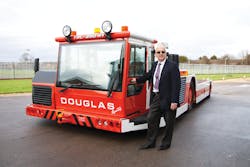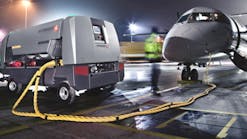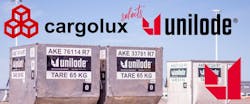Michael Doane Retires After 50 Years At Douglas Equipment
Anyone looking for GSE career advice should just ask Michael Doane for his.
“You have joined a great industry in which no two days are the same,” he says. “You will face new challenges every day that will test your knowledge and skills and bring you great satisfaction. You will also enjoy working in a very friendly industry that crosses all national, political and economic boundaries and which offer great opportunities and rewards.”
The fact that we dug up that gem from an interview Ground Support Worldwide did with Doane years ago makes it no less relevant today as we talked with him again about his long career at Douglas Equipment.
Earlier this year, Doane accomplished what few of us have by stepping down from his sales and marketing position at his one-and-only employer after traveling the world selling GSE facing those new challenges day after day with no two days alike in a career spanning 50 years.
APPRENTICESHIP
“They gave an excellent start for a young person,” he says by way of explaining his entry into the international ground support equipment manufacturer.
Doane originally joined the company in 1963 as part of a five-year engineering apprenticeship program. Eventually, he became a production engineer in 1968 and moved up the ladder working mainly in design and production until 1974.
From that point, Doane moved into sales eventually becoming a technical sales manager in 1979, general sales manager in 1987 and, finally, sales and marketing director in 1988.
Thanks in large part to Doane’s work developing the Douglas brand, the company now exports 95 percent of its product worldwide to countries, including Europe, Scandinavia, North American, Middle East, Southeast Asia, Australia, Russia, China and Japan.
“The GSE industry operates in very special global niche market that is very competitive market,” he says. “Therefore, winning any order for high-value equipment is a challenge.”
TOWBARLESS CONCEPT
While we don’t pretend to be able to sum up a half-century career in a few pages, Doane takes particular pride in growing the company’s towbarless concept in the 1990s with its original model, the TBL 180.
“Bear in mind that, certainly in the early days, this was a relatively new way of handling aircraft,” he adds. “So the challenge always was to persuade the potential customer that the concept was going to increase operational efficiency, reduce operational costs and increase operational flexibility while protecting the aircraft at all times in a cost-effective way.”
Douglas was no stranger to the GSE industry and was one of the first companies in capitalize on the expanding aviation market when it started manufacturing aircraft towing tractors in 1947.
By the beginning of the 1990s, however, at least two other GSE manufacturers were introducing a new idea – the towbarless tractor. While a bit late to the party, Douglas more than made up for it.
“From the very beginning, we focused on a cost-effective concept and design that could be included across all models in the range we were planning,” Doane explains. “We started with the driveline and, after a great deal of research, opted for what we call a conventional driveline with low maintenance and repair costs, that is conventional torque converters and power shift transmissions and conventional mechanical drive-steer axles that are the same type of drivelines we use in our conventional aircraft towing tractors.”
The towbarless equipment also featured a unique nose landing gear cradle that enables the tractor to be coupled to the aircraft without moving it.
“Therefore, the coupling / uncoupling procedure can be undertaken at anytime during ground operations,” he says. “It fully supports the aircraft’s NLG under all conditions even if all systems fail.”
Douglas also pioneered the use of electronically controlled multi-mode steering systems in and now use CanBus controls throughout its designs.
During this time, Doane travelled extensively throughout the world and grew the company’s global market share for towbarless equipment to a high of 60 percent in less than five years after the product’s introduction.
“In those early days of the towbarless tractors,” he says, “we had tremendous support from our customer base around the world who were able to give us access to aircraft to enable us to complete the airframe manufactures approval tests with each tractor for each model of aircraft it was designed to handle.”
Despite his world travels, one of Doane’s first major sales for towbarless equipment was decidedly closer to home.
Following many months of meetings, discussions and technical presentations, British Airways decided to convert its aircraft handling operations at Heathrow and Gatwick to the towbarless concept in the mid-1990s,
“This was part of an airline-wide drive to increase operation efficiency, reduce operational costs and increase operational flexibility,” Doane adds. “Towbarless equipment was going to be the key to the airline’s ongoing development of its ground operations.”
Doane was able to persuade the airline with "well presented technical presentations, factually based and supported" that the Douglas concept was the right solution. As a result, Douglas received what was at the time the largest order for towbarless tractors ever placed, and included TBL 180s, TBL 280s and TBL 400s.
Douglas’ towbarless equipment soon spread throughout the world:
- In the Middle East, for example, Emirates ground handing division DNATA was one of the first major handling companies to adopt the towbarless concept.
- A sale of a fleet of Douglas TBL 180 towbarless tractors to American Airlines for pushback operations helped the company break into the U.S. market. The American Airlines sale quickly led to substantial orders from Continental Airlines for TBL 280 and TBL 400 towbarless tractors for maintenance towing operations in Newark and Houston.
- At the same time with the support of Air Canada, Doane gained an introduction into the Canadian market with sales of the TBL 280 and TBL 400s.
“I think we are now an established supplier to the North American market having secured orders over the last 10-15 years from many more North American airlines,” he says.
Of course, Doane was marketing more than just towbarless equipment in the 35 years he spent in the sales and marketing department. More than 40 percent of the company’s production is, in fact, still in conventional aircraft towing tractors.
“And this range of products have also seen great strides in development,” he says.
While Doane “retired” last March, he remains a consultant with Douglas. He was also asked to take up the position of honorary president at the British Airport Services and Equipment Association, which helps member companies promote their products and services – and a group he led as chairman for seven years during his busy Douglas career.
"It is an opportunity to stay involved in the industry and give other companies the benefit of my experience," he adds.






